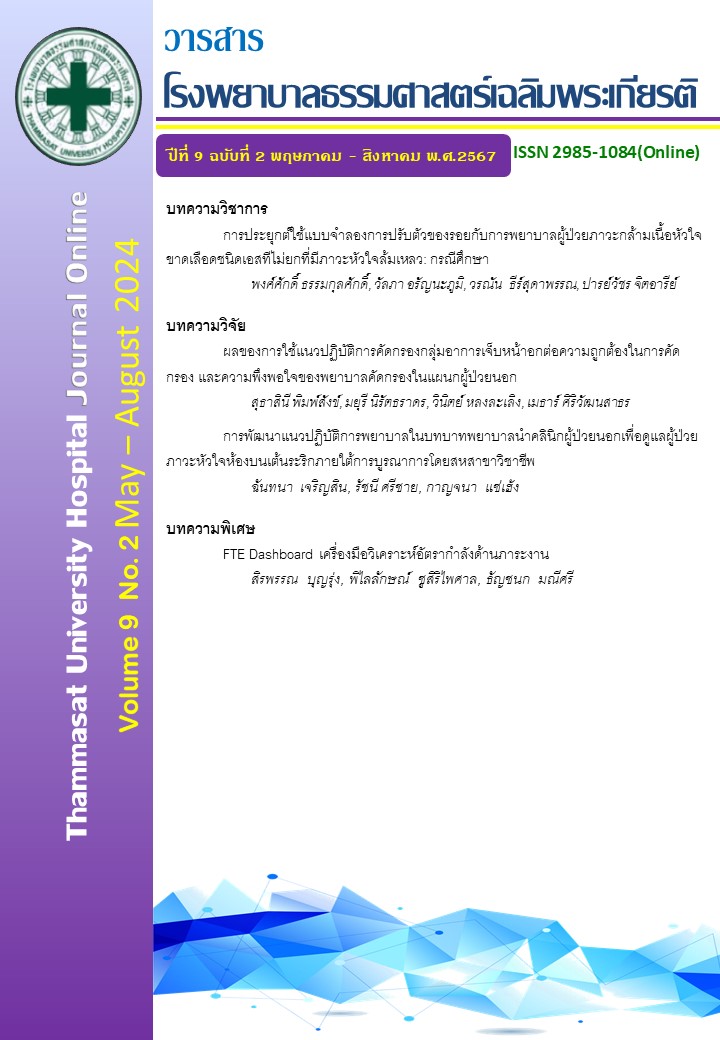Application of Roy’s Adaptation Model in Nursing care for Non-ST Elevation Myocardial Infarction Patients with Congestive Heart Failure: Case Study
Keywords:
Roy’s Adaptation Model, nursing, non-ST elevation myocardial infarction, congestive heart failureAbstract
Non-ST elevation myocardial infarction (non-STEMI) is one of the common causes of death among Thai elderly. Once the condition has stabilized, if the patient cannot adapt to the changed lifestyle, they often return to the hospital with more serious complications. Roy's adaptation model is directly related to the nursing process. Therefore, it could be applied to the nursing of non-ST elevation myocardial infarction patients with congestive heart failure. The patient could adapt it to this critical illness. The purpose of this article is to describe nursing care for non-ST elevation myocardial infarction patients with congestive heart failure according to Roy’s adaptation concept and to provide guidance for nurses in planning patient care.
A case study of a 68-year-old female patient was discussed. When the doctor diagnosed her with non-ST elevation myocardial infarction and congestive heart failure, there was an assessment of adjustment in a total of 4 areas (physical, self-concept, role and duty, and interdependence) and identified care problems that could be resolved by nursing. From stimuli analysis within the theoretical framework, they may be a stimulus that limits the patient's ability to adapt. Each care problem uses NANDA-I nursing diagnosis and patient nursing planning according to the nursing process. Roy's adaptation model could be used as a guideline for nurses in planning care for non-ST elevation myocardial infarction patients with congestive heart failure. This helps the patient adjust appropriately. The good health and quality of life could be achieved with this disease.
References
ฉัตรพร หัตถกรรม, วนิดา เคนทองดี, พรวีนัส โสกัณทัต. การพัฒนาแนวปฏิบัติการพยาบาลผู้ป่วยโรคกล้ามเนื้อหัวใจขาดเลือดเฉียบพลัน ชนิดคลื่น เอส ที ไม่ยกสูงโรงพยาบาลเลย. วารสารการพยาบาลและการดูแลสุขภาพ. 2564;39(2):87-96.
สมาคมแพทย์โรคหัวใจแห่งประเทศไทย ในพระบรมราชูปถัมภ์ฯ. แนวเวชปฏิบัติการดูแลรักษาผู้ป่วยภาวะหัวใจขาดเลือดเฉียบพลัน พ.ศ.2563. กรุงเทพฯ:เนคสเตป ดีไซน์;2563
ธัญญวรรณ บุญผล. การพยาบาลผู้ป่วยกล้ามเนื้อหัวใจขาดเลือดเฉียบพลันชนิดคลื่นเอสทีไม่ยกร่วมกับภาวะหัวใจหยุดเต้น. วารสารวิจัยและวิชาการสาธารณสุขจังหวัดพิจิตร. 2566;4(2):158-69.
สถาบันโรคทรวงอก กรมการแพทย์ กระทรวงสาธารณสุข. Thai ACS registry [Internet]. 2566 [2 เมษายน 2567]. เข้าถึงได้จาก: https://ncvdt.org/document/THAI%20ACSREGISTRY66final.pdf
แจ่มจันทร์ ประทีปมโนวงศ์. การพยาบาลผู้สูงอายุกลุ่มอาการกล้ามเนื้อหัวใจขาดเลือดเฉียบพลันชนิดเอสทีไม่ยก. วารสารพยาบาลสภากาชาดไทย. 2564;14(1):66-81.
Basit H, Malik A, Huecker MR. Non-ST Segment Elevation Myocardial Infarction [internet]. StatPearls Publishing; 2023 (cited 2024 April 2). Available from: https://www.ncbi.nlm.nih.gov/books/NBK513228/
จินตนา นาคพิน. การพยาบาลผู้ป่วยโรคกล้ามเนื้อหัวใจขาดเลือดเฉียบพลันชนิดคลื่นเอสทีไม่ยก ที่มีโรคร่วม : กรณีศึกษา 2 ราย. วารสารวิจัยและนวัตกรรมทางสุขภาพ. 2564;4(1):28-39.
ศุภวัลย์ เลิศพงศ์ภาคภูมิ, เจนเนตร พลเพชร, จอม สุวรรณโณ. ปัจจัยทำนายการกลับเข้าพักรักษาซ้ำภายในช่วงเวลา 1 ปี หลังจำหน่ายออกจากโรงพยาบาลด้วยภาวะหัวใจล้มเหลวเฉียบพลัน. วารสารพยาบาลโรคหัวใจและทรวงอก. 2562;30(2):126-40.
Dai X, Busby-Whitehead J, Alexander KP. Acute coronary syndrome in the older adults. J Geriatr Cardiol. 2016;13(2):101-8.
Roy C, Andrews HA. The Roy adaptation model. In: McEwen M, Wills E, editors. Theoretical basis for nursing. USA: Lippincott Williams & Wilkins;1999.
Roy C. The Roy Adaptation Model. 3rd ed. Upper Saddle River, NJ: Pearson Education;2009.
Huang S, Xie X, Wu S. Applying Roy Adaptation Model (RAM) in Assessing Health of Patient with Post-operative Coronary Artery Bypass Graft (CABG) Surgery. HPBS. 2015;1(2):10-8.
เบญญาภา พรมพุก, วันชัย เลิศวัฒนวิลาศ, จินดาวรรณ เงารัศมี, ต่อพงษ์ บุญมาประเสริฐ. การประยุกต์ใช้รูปแบบการปรับตัวของรอยสำหรับผู้ที่เป็นโรคหมอนรองกระดูกเคลื่อนทับเส้นประสาท: กรณีศึกษา. วารสารการพยาบาลและสุขภาพ. 2564;15(1):14-27.
สมพร มีนะโน, จตุพร เสือมี, สุนี จิรสมิทธา. ผลของโปรแกรมการพยาบาลตามทฤษฏีของรอยต่อพฤติกรรมการปรับตัว และระดับการควบคุมโรคหืด. วารสารพุทธชินราชเวชสาร. 2561;35(2):215-23.
ปิยะนุช แหน่งเพ็ชร, บุศรา หมื่นศรี, จารุวรรณ มานะสุรการ. พฤติกรรมการปรับตัวของผู้ป่วยโรคเอสแอลอี. ใน: ปกรณ์ ลิ้มโยธิน. การประชุมหาดใหญ่วิชาการระดับชาติและนานาชาติครั้งที่ 8; 22 มิถุนายน 2560; มหาวิทยาลัยหาดใหญ่. สงขลา:มหาวิทยาลัยหาดใหญ่; 2560. 39-48.
ชิตชวรรณ คงเกษม, สุนีย์ ละกำปั่น, ปิยะธิดา จึงสมาน. โปรแกรมส่งเสริมการปรับตัวสำหรับผู้ป่วยไตวายเรื้อรังระยะสุดท้ายที่รักษาด้วยวิธีการล้างไตทางช่องท้อง. วารสารพยาบาลสาธารณสุข. 2560;31(1):75-89.
อมราวดี บุญยรัตน์. การออกกำลังกายเพื่อการฟื้นฟูสภาพในผู้ที่มีภาวะหัวใจล้มเหลวที่มีอาการคงที่. รามาธิบดีพยาบาลสาร. 2560;24(1):13-24.
เจนจิรา เกียรติสินทรัพย์, สาริณี โต๊ะทอง, ทานตะวัน แย้มบุญเรือง. ผลของการใช้โปรแกรมจัดการความเครียดต่อความสามารถจัดการความเครียดและระดับความเครียดของผู้สูงอายุในเขตอำเภอเมืองนนทบุรี. วารสารเกื้อการุณย์. 2562;26(2):66-77.
Downloads
Published
How to Cite
Issue
Section
License
Copyright (c) 2024 Thammasat University Hospital Journal Online

This work is licensed under a Creative Commons Attribution-NonCommercial-NoDerivatives 4.0 International License.



